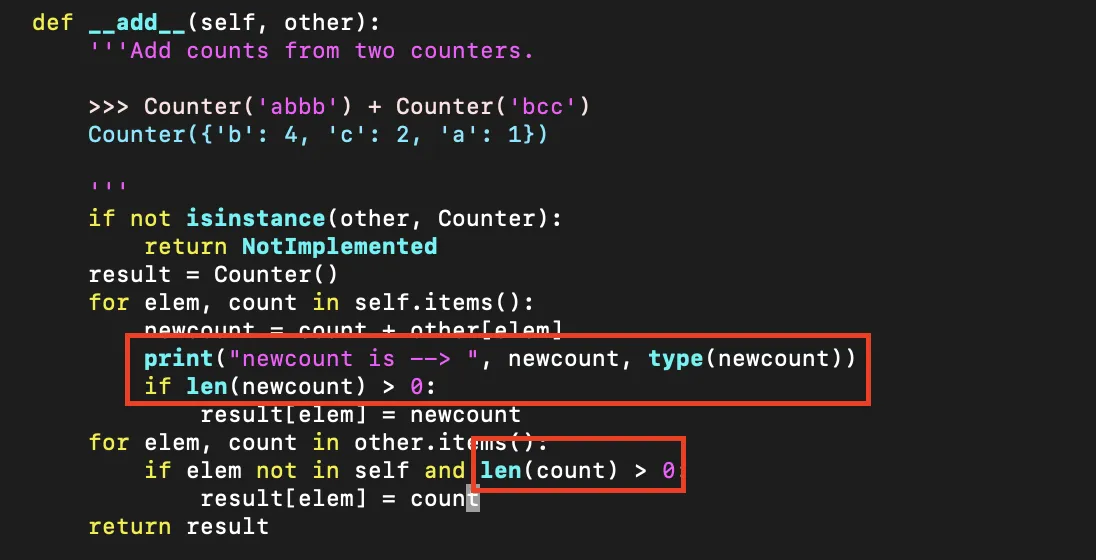有两个字典
x={1:['a','b','c']}
y={1:['d','e','f'],2:['g']}
我希望得到一个新的字典 z,它是由 x 和 y 合并而成的,满足以下条件:
z = {1:['a','b','c','d','e','f'],2:['g']}
这个操作能做到吗?我尝试了更新操作。
x.update(y)
但是它给了我以下结果。
z= {1:['d','e','f'],2:['g']}
有两个字典
x={1:['a','b','c']}
y={1:['d','e','f'],2:['g']}
z = {1:['a','b','c','d','e','f'],2:['g']}
这个操作能做到吗?我尝试了更新操作。
x.update(y)
z= {1:['d','e','f'],2:['g']}
一行解决方案:
{ key:x.get(key,[])+y.get(key,[]) for key in set(list(x.keys())+list(y.keys())) }
示例1:
x={1:['a','b','c']}
y={1:['d','e','f'],2:['g']}
{ key:x.get(key,[])+y.get(key,[]) for key in set(list(x.keys())+list(y.keys())) }
输出:
{1: ['a', 'b', 'c', 'd', 'e', 'f'], 2: ['g']}
例子2:
one = {'a': [1, 2], 'c': [5, 6], 'b': [3, 4]}
two = {'a': [2.4, 3.4], 'c': [5.6, 7.6], 'd': [3.5, 4.5]}
{ key:one.get(key,[])+two.get(key,[]) for key in set(list(one.keys())+list(two.keys())) }
输出:
{'a': [1, 2, 2.4, 3.4], 'b': [3, 4], 'c': [5, 6, 5.6, 7.6], 'd': [3.5, 4.5]}
for k, v in x.items():
if k in y.keys():
y[k] += v
else:
y[k] = v
遍历字典获取键和值,检查键是否已存在,如果存在则添加,否则添加新的键和值。如果你的值是混合数据类型而不是列表类型,那么这种方法将行不通。
x={1:['a','b','c'], 3:['y']}
.. y={1:['d','e','f'],2:['g']}
..
..
.. for k, v in x.items():
.. if k in y.keys():
.. y[k] += v
.. else:
.. y[k] = v
..
.. print y
{1: ['d', 'e', 'f', 'a', 'b', 'c'], 2: ['g'], 3: ['y']}
final = {}
dicts = [x,y] # x and y are each dicts defined by op
for D in dicts:
for key, value in D.items(): # in python 2 use D.iteritems() instead
final[key] = final.get(key,[]).extend(value)
final.get(key,[])会获取final中对应键值的值,如果不存在,则返回一个空列表。 .extend(value)将扩展该列表(无论是否为空)与D中对应的值,此处为x或y。
d1={'a':[1,2,3], 'b':[4,5,6], 'c':[7,8,9]}
d2 = {'a':[10,11,12], 'b':[13,14,15], 'c':[16,17,18]}
d3 = {}
for k in d1.keys():
d3.update( {k : []} )
for i in d1[k]:
d3[k].append(i)
for j in d2[k]:
d3[k].append(j)
print(d3)
这是一个针对任意数量字典的Python 3解决方案:
def dict_merge(*dicts_list):
result = {}
for d in dicts_list:
for k, v in d.items():
result.setdefault(k, []).append(v)
return result
set():def dict_merge(*dicts_list):
result = {}
for d in dicts_list:
for k, v in d.items():
result.setdefault(k, set()).add(v)
return result
如果您在项目中选择Python2.7。Counter() 可以在这种情况下使用:
Python 2.7.16 (default, Jun 5 2020, 22:59:21)
[GCC 4.2.1 Compatible Apple LLVM 11.0.3 (clang-1103.0.29.20) (-macos10.15-objc- on darwin
Type "help", "copyright", "credits" or "license" for more information.
>>> x={1:['a','b','c']}
>>> y={1:['d','e','f'],2:['g']}
>>> from collections import Counter
>>> Counter(x) + Counter(y)
Counter({2: ['g'], 1: ['a', 'b', 'c', 'd', 'e', 'f']})
Python 3.9.0 (v3.9.0:9cf6752276, Oct 5 2020, 11:29:23)
Type 'copyright', 'credits' or 'license' for more information
IPython 7.19.0 -- An enhanced Interactive Python. Type '?' for help.
In [1]: x={1:['a','b','c']}
In [2]: y={1:['d','e','f'],2:['g']}
In [3]: from collections import Counter
In [4]: Counter(x) + Counter(y)
---------------------------------------------------------------------------
TypeError Traceback (most recent call last)
<ipython-input-4-0aa8b00837b3> in <module>
----> 1 Counter(x) + Counter(y)
/Library/Frameworks/Python.framework/Versions/3.9/lib/python3.9/collections/__init__.py in __add__(self, other)
759 for elem, count in self.items():
760 newcount = count + other[elem]
--> 761 if newcount > 0:
762 result[elem] = newcount
763 for elem, count in other.items():
TypeError: '>' not supported between instances of 'list' and 'int'
让我们来看一下源代码,位于vim /Library/Frameworks/Python.framework/Versions/3.9/lib/python3.9/collections/__init__.py +761
为了检查Python2.x和Python3.x之间的区别,我们将找到Python2.x中collections的路径。只需执行错误调用即可:
>>> Counter(9,1) # wrong way to call.
Traceback (most recent call last):
File "<stdin>", line 1, in <module>
File "/System/Library/Frameworks/Python.framework/Versions/2.7/lib/python2.7/collections.py", line 475, in __init__
raise TypeError('expected at most 1 arguments, got %d' % len(args))
TypeError: expected at most 1 arguments, got 2
然后,你会看到 /System/Library/Frameworks/Python.framework/Versions/2.7/lib/python2.7/collections.py。
好的,现在打开两个文件并定位到 class Counter 中的__add__函数。
vim -d /Library/Frameworks/Python.framework/Versions/3.9/lib/python3.9/collections/__init__.py +761 /System/Library/Frameworks/Python.framework/Versions/2.7/lib/python2.7/collections.py
但是我们可以在这个代码片段中找到区别。
想一想,你可以看到TypeError: '>' not supported between instances of 'list' and 'int'显示了两个重要的事情:
>反映了class dict中的def __gt__(self, value, /)方法。所以让我们来检查一下Python2和Python3 dict之间的区别。'list'和'int'。为了确保我们在这里遇到相同的类型,只需添加一行代码将其打印出来。在执行比较行if newcount > 0:之前,像这样进行:print("newcount is --> ", newcount, type(newcount))
if newcount > 0:
然后你会看到这个:
不意外,对吧?我们可以将list与int进行比较,这是有道理的。
让我们快速比较一下Python 2中的list和int。
好的,现在你应该清楚发生了什么。要解决这个问题,你可以轻松地对自己的Python环境进行一些更改或将其提交到git。

最后,你得到了两个好消息,你修复了Python3.x的错误,并且获得了你的结果。
如果你想要的结果是一个字典,你可以使用以下方法:z = dict(Counter(x) + Counter(y))
>' not supported between instances of 'list' and 'int'。意思是在列表和整数之间无法使用 > 进行比较。 - Frank AK
D.iteritems()吧? - gtangilfinal.get(key,[])不会返回一个空列表,它会返回一个 NoneType 并抛出一个错误。 - Mdevfinal[key] = final.get(key, []) + value。 - Trody